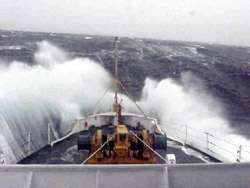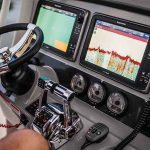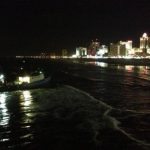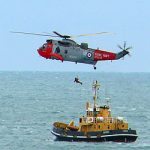Your VHF radio weather forecast wasn’t so promising this morning when you decided to leave the dock for the next leg of your cruise, but you consulted with the wife and kids and the unanimous vote was to go. After all, you didn’t take this vacation to spend it sitting around an anchorage, and there are new adventures waiting at your next port-of-call. Sure, NOAA said there might be a fast moving front passing through later in the day, but skies were blue and the morning sun was warming. Now, several hours later and a couple or more dozen miles out, you begin to wonder if you made the right decision. The winds have changed direction, seas are building and the sky is darkening. It’s obvious that you’re going to be in heavy weather very soon, and you need to make preparations.
Every recreational boater on any body of water will experience a similar situation at least once. How you prepare for your encounter with bad weather will make the difference between a minor inconvenience and an unpleasantly risky ordeal. Preparedness always translates into cool judgment under pressure, and that’s one of the main ingredients for safety at sea.
When heavy weather is imminent, you’ll first want to take steps to safeguard your most important assets. Get out the lifejackets and make sure that everybody has one on. Make sure the jackets are the right size for each passenger, that they are adjusted properly. If it’s cold, make sure they are wearing appropriate waterproof and warm clothing. If it’s dark, make sure each PFD has a battery-operated light or strobe attached high on the vest. If you have safety harnesses, prepare them for use. Take time to reassure your passengers that you have the situation well in control. If you think you’ll be needing their assistance, tell them what you’ll expect them to do and under what circumstances. If things get rough, the last thing you’ll want on board is panic and confusion. Dispense seasick tablets if you suspect that might be a problem. And finally, at the point that it starts getting hairy, get everybody below who is not absolutely needed topside.
Next, break out all the gear that you might need later. That might include storm anchors, drogues, hand pumps and flashlights. Make sure you have plenty of line to run out on your storm anchor. In a brisk wind once on Lake Michigan, we were practicing deployment of a sea anchor in a brisk wind and were able to reduce our drift from 3 knots to 0 knots by simply letting out 100 more feet of line to the drogue.
Close and secure all hatches, windows and ports. If you have ventilation opening on the deck, close them off or cover them loosely so that water can’t get in but air can, if it’s possible for you to make that compromise. Plug any other open deck fitting where water could enter, such as your hawse pipe.
If you already have water in your bilge, pump it out. When your boat starts rocking and rolling, you won’t want the sloshing of shifting water making it worse.
Make sure you know where you are. Check your position and update your chart. And while you’re in the chartroom, or wherever you happen to do your navigation work, make note of the nearest sheltered areas if near enough to shore. Consider your chances of making a run for safe haven before the storm makes that impossible.
Although you may not have time for a full charge if your batteries are very low, throw the charger on all batteries and do what you can. Check the operation of electrically operated pumps.
Once you’re in the storm’s fury, you’ll need to exercise all your heavy weather seamanship skills. You’ll do all the right things that you’ve prepared for through your experience and education. You’ll run at an angle to the waves, you’ll post lookouts, and you’ll take advantage of everything you’ve ever learned about dealing with weather. But as with most things, your success in facing bad weather and heavy seas will be in direct proportion to the degree of your preparation on board, that day. Just remember, prepare for the safety and well being of your passengers first. Then you can tend to the vessel, which will bring them, in the hands of a skillful captain, safely through the storm and home again.








